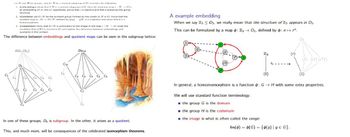
Elements Of Modern Algebra
8th Edition
ISBN: 9781285463230
Author: Gilbert, Linda, Jimmie
Publisher: Cengage Learning,
expand_more
expand_more
format_list_bulleted
Question

Transcribed Image Text:Hm, and let № be anomalous of G. Codes following:
1. embeddings show that if Na normal subgroup of G. then the inchesion map N→→G
an embedding of N into G. Specifically, prove that is injective and that it preserves the group
structure.
2. (Quotients) Let G/N be the quotient group formed by the cosets of N in G. Prove that the
quotient map : G G/N, defined by (9) N. it a surjection and show that it is a
homomorphiam.
3. (Comparison) Show that G/N is isomorphic to the image of the map : N G under the
condition that (N) normal m G. and uxplain the dillerence between embeddings and
quotients in this context.
The difference between embeddings and quotient maps can be seen in the subgroup lattice:
A example embedding
When we say 3D3, we really mean that the structure of 23 appears in D3.
This can be formalized by a map : Z3D3, defined by : nr.
AGL1(Z5)
C10
Dic 10
CA Co Co Ca
23
(f) (rf) (r²f)
c
(0)
(1)
C2 C2 C2
In one of these groups, D5 is subgroup. In the other, it arises as a quotient.
This, and much more, will be consequences of the celebrated isomorphism theorems.
In general, a homomomorphism is a function : G H with some extra properties.
We will use standard function terminology:
■the group G is the domain
the group H is the codomain
■the image is what is often called the range:
Im() = (G) = {(9)|gЄG}.
Expert Solution
This question has been solved!
Explore an expertly crafted, step-by-step solution for a thorough understanding of key concepts.
Step by stepSolved in 2 steps with 3 images

Knowledge Booster
Similar questions
- 11. Find all normal subgroups of the alternating group .arrow_forwardLet G be the group and H the subgroup given in each of the following exercises of Section 4.4. In each case, is H normal in G? Exercise 3 b. Exercise 4 c. Exercise 5 d. Exercise 6 e. Exercise 7 f. Exercise 8 Section 4.4 Let H be the subgroup e, of the octic group D4. Find the distinct left cosets of H in D4, write out their elements, partition D4 into left cosets of H, and give [D4:H]. Find the distinct right cosets of H in D4, write out their elements, and partition D4 into right cosets of H. Let H be the subgroup e, of the octic group D4. Find the distinct left cosets of H in D4, write out their elements, partition D4 into left cosets of H, and give [D4:H]. Find the distinct right cosets of H in D4, write out their elements, and partition D4 into right cosets of H. Let H be the subgroup e, of the octic group D4. Find the distinct left cosets of H in D4, write out their elements, partition D4 into left cosets of H, and give [D4:H]. Find the distinct right cosets of H in D4, write out their elements, and partition D4 into right cosets of H. Let H be the subgroup (1),(2,3) of S3. Find the distinct left cosets of H in S3, write out their elements, partition S3 into left cosets of H, and give [S3:H]. Find the distinct right cosets of H in S3, write out their elements, and partition S3 into right cosets of H. In Exercises 7 and 8, let G be the multiplicative group of permutation matrices I3,P3,P32,P1,P4,P2 in Example 6 of Section 3.5 Let H be the subgroup of G given by H=I3,P4={ (100010001),(001010100) }. Find the distinct left cosets of H in G, write out their elements, partition G into left cosets of H, and give [G:H]. Find the distinct right cosets of H in G, write out their elements, and partition G into right cosets of H. Let H be the subgroup of G given by H=I3,P3,P32={ (100010001),(010001100),(001100010) }. Find the distinct left cosets of H in G, write out their elements, partition G into left cosets of H, and give [G:H]. Find the distinct right cosets of H in G, write out their elements, and partition G into right cosets of H.arrow_forward22. If and are both normal subgroups of , prove that is a normal subgroup of .arrow_forward
- With H and K as in Exercise 18, prove that K is a normal subgroup of HK. Exercise18: If H is a subgroup of G, and K is a normal subgroup of G, prove that HK=KH.arrow_forwardProve or disprove that H={ [ 1a01 ]|a } is a normal subgroup of the special linear group SL(2,).arrow_forward3. Consider the group under addition. List all the elements of the subgroup, and state its order.arrow_forward
arrow_back_ios
SEE MORE QUESTIONS
arrow_forward_ios
Recommended textbooks for you
 Elements Of Modern AlgebraAlgebraISBN:9781285463230Author:Gilbert, Linda, JimmiePublisher:Cengage Learning,
Elements Of Modern AlgebraAlgebraISBN:9781285463230Author:Gilbert, Linda, JimmiePublisher:Cengage Learning,

Elements Of Modern Algebra
Algebra
ISBN:9781285463230
Author:Gilbert, Linda, Jimmie
Publisher:Cengage Learning,